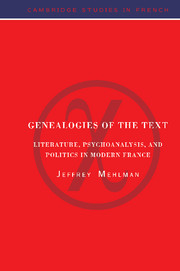Book contents
- Frontmatter
- Contents
- Acknowledgments
- 1 Introduction
- 2 Craniometry and criticism: notes on a Valéryan criss-cross
- 3 Literature and hospitality: Klossowski's Hamann
- 4 Literature and collaboration: Benoist-Méchin's return to Proust
- 5 “Pierre Menard, author of Don Quixote” again
- 6 Iphigenia 38: deconstruction, history, and the case of L'Arrêt de mort
- 7 Writing and deference: the politics of literary adulation
- 8 Perspectives: on Paul de Man and Le Soir
- 9 Prosopopeia revisited
- 10 The paranoid style in French prose: Lacan with Léon Bloy
- 11 The Holocaust comedies of “Emile Ajar”
- 12 Pour Sainte-Beuve: Maurice Blanchot, 10 March 1942
- 13 Flowers of evil: Paul Morand, the Collaboration, and literary history
- Appendix
- Notes
- Index
- Series list
9 - Prosopopeia revisited
Published online by Cambridge University Press: 19 January 2010
- Frontmatter
- Contents
- Acknowledgments
- 1 Introduction
- 2 Craniometry and criticism: notes on a Valéryan criss-cross
- 3 Literature and hospitality: Klossowski's Hamann
- 4 Literature and collaboration: Benoist-Méchin's return to Proust
- 5 “Pierre Menard, author of Don Quixote” again
- 6 Iphigenia 38: deconstruction, history, and the case of L'Arrêt de mort
- 7 Writing and deference: the politics of literary adulation
- 8 Perspectives: on Paul de Man and Le Soir
- 9 Prosopopeia revisited
- 10 The paranoid style in French prose: Lacan with Léon Bloy
- 11 The Holocaust comedies of “Emile Ajar”
- 12 Pour Sainte-Beuve: Maurice Blanchot, 10 March 1942
- 13 Flowers of evil: Paul Morand, the Collaboration, and literary history
- Appendix
- Notes
- Index
- Series list
Summary
Prosopopeia, during the last years of Paul de Man's life, served as something of the abracadabra of his own brand of deconstructive criticism. In the strict sense, the term designates the figure through which an absent or deceased person is represented as speaking. De Man, however, through a series of ingenious but arbitrary analyses, sought to generalize it to the very bounds of literature: through epitaph, it became the “dominant figure” of autobiography; through apostrophe, the “master-trope” of poetry; through etymology (“to confer a mask or face”), something akin to personification; and finally, through its appeal to an absent other, the “very figure of the reader and of reading.” Jacques Derrida's gesture of fidelity in Mémoires: for Paul de Man, the three baroque essays he devoted to his deceased friend, lay in returning to prosopopeia in the strict sense, giving voice to his friend in the form of a masterly rehearsal of de Man's thoughts on memory, but also in the concluding discursive gesture of reading an unpublished piece by de Man, as it were, from beyond the grave. A certain amount of fanfare prepares Derrida's revelation of that text, the first letter he received (in 1971) from de Man, in which the critic, in rather mannerly fashion, runs through his differences with Derrida on the subject of Rousseau and refers in passing to Rousseau's madness. Derrida puffs up his prose and wonders (in a decrescendo Proust might have savored) whether the mere act of quoting personal correspondance in a public forum is not “abusive, violent, indiscreet”? He makes bold to go on, invents a new transgression.
- Type
- Chapter
- Information
- Genealogies of the TextLiterature, Psychoanalysis, and Politics in Modern France, pp. 131 - 138Publisher: Cambridge University PressPrint publication year: 1995

